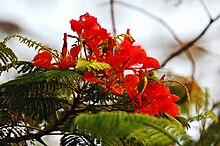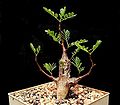
The Mimosoideae are a traditional subfamily of trees, herbs, lianas, and shrubs in the pea family (Fabaceae) that mostly grow in tropical and subtropical climates. They are typically characterized by having radially symmetric flowers, with petals that are twice divided (valvate) in bud and with numerous showy, prominent stamens.

The Fabaceae or Leguminosae, commonly known as the legume, pea, or bean family, are a large and agriculturally important family of flowering plants. It includes trees, shrubs, and perennial or annual herbaceous plants, which are easily recognized by their fruit (legume) and their compound, stipulate leaves. The family is widely distributed, and is the third-largest land plant family in number of species, behind only the Orchidaceae and Asteraceae, with about 765 genera and nearly 20,000 known species.
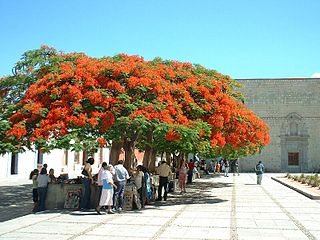
Caesalpinioideae is a botanical name at the rank of subfamily, placed in the large family Fabaceae or Leguminosae. Its name is formed from the generic name Caesalpinia. It is known also as the peacock flower subfamily. The Caesalpinioideae are mainly trees distributed in the moist tropics, but include such temperate species as the honeylocust and Kentucky coffeetree. It has the following clade-based definition:
The most inclusive crown clade containing Arcoa gonavensisUrb. and Mimosa pudicaL., but not Bobgunnia fistuloides(Harms) J. H. Kirkbr. & Wiersema, Duparquetia orchidaceaBaill., or Poeppigia proceraC.Presl

Cercis is a genus of about 10 species in the subfamily Cercidoideae of the pea family Fabaceae. It contains small deciduous trees or large shrubs commonly known as redbuds in the USA. They are characterised by simple, rounded to heart-shaped leaves and pinkish-red flowers borne in the early spring on bare leafless shoots, on both branches and trunk ("cauliflory"). The genus contains ten species, native to warm temperate regions of North America, southern Europe, western and central Asia, and China.

Delonix regia is a species of flowering plant in the bean family Fabaceae, subfamily Caesalpinioideae native to Madagascar. It is noted for its fern-like leaves and flamboyant display of orange-red flowers over summer. In many tropical parts of the world it is grown as an ornamental tree and in English it is given the name royal poinciana, flamboyant, phoenix flower, flame of the forest, or flame tree.

Parkia is a genus of flowering plants in the family Fabaceae. It belongs to the mimosoid clade of the subfamily Caesalpinioideae. Several species are known as African locust bean.

Dimorphandra is a genus of legume in the family Fabaceae, subfamily Caesalpinioideae. It includes 26 species native to northern South America, ranging from Colombia and Venezuela to Bolivia, Paraguay, and southeastern Brazil.
Vouacapoua is a genus of legume in the family Fabaceae, subfamily Caesalpinioideae. It includes three species of trees native to northern South America, ranging from the Guianas to northern and northeastern Brazil. They grow in terre firme Amazonian rain forest.

Peltophorum is a genus of 5–15 species of flowering plants in the family Fabaceae, subfamily Caesalpinioideae. The genus is native to certain tropical regions across the world, including northern South America, central and southern Africa, Indochina, southeastern China, Malesia, New Guinea, and northern Australia. The species are medium-sized to large trees growing up to 15–25 m tall, rarely 50 m.

Cercidoideae is a subfamily in the pea family, Fabaceae. Well-known members include Cercis (redbuds), including species widely cultivated as ornamental trees in the United States and Europe, Bauhinia, widely cultivated as an ornamental tree in tropical Asia, and Tylosema, a semi-woody genus of Africa. The subfamily occupies a basal position within the Fabaceae and is supported as monophyletic in many molecular phylogenies. At the 6th International Legume Conference, the Legume Phylogeny Working Group proposed elevating the tribe Cercidae to the level of subfamily within the Leguminosae (Fabaceae). The consensus agreed to the change, which was fully implemented in 2017. It has the following clade-based definition:
The most inclusive crown clade containing Cercis canadensisL. and Bauhinia divaricataL. but not Poeppigia proceraC.Presl, Duparquetia orchidaceaBaill., or Bobgunnia fistuloides(Harms) J.H.Kirkbr. & Wiersema.

Recordoxylon is a genus of flowering plants in the legume family, Fabaceae. It includes three species of trees native to the tropical Amazon rainforest of northern South America, and the species' range includes northern Brazil, Colombia, French Guiana, Guyana, and Venezuela. Habitats include non-flooded rain forest on terra firme, seasonally-flooded riverine forest (várzea), and montane forest.

Zuccagnia punctata is a species of flowering plant in the family Fabaceae. It is the sole species in genus Zuccagnia. It belongs to tribe Caesalpinieae of subfamily Caesalpinioideae.
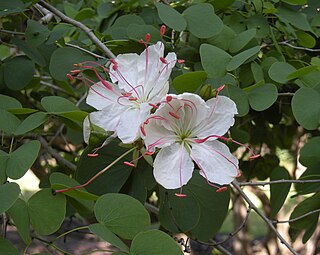
Lysiphyllum is a genus of flowering plants in the legume family, Fabaceae. It includes nine species of trees, semi-scandent shrubs, and lianas which range from India through Southeast Asia to Australasia. Typical habitats include seasonally-dry tropical forest and woodland, vine thickets, Brigalow and Gidgee scrubland, floodplains, alluvial flats, tidal forest, mangroves, river and stream banks, and occasionally dunes and coral islets. They can grow on diverse soils including calcareous, granitic, and basaltic.
Hesperalbizia is a genus of flowering plants in the family Fabaceae. It belongs to the mimosoid clade of the subfamily Caesalpinioideae. The only species is Hesperalbizia occidentalis. It is native to Mexico and is known by the common name palo escopeta.
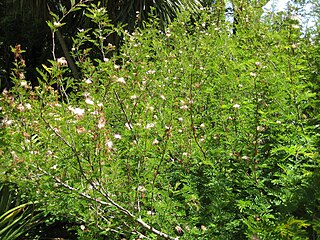
Zapoteca is a genus of flowering plants in the family Fabaceae, in the mimosoid clade of the subfamily Caesalpinioideae. It was separated from the genus Calliandra in 1986 on the basis of chromosome numbers, pollen, seedling structure, and other features. It is named in honour of the Zapotec peoples.

Pentaclethra is a small genus of trees from the tropics. They are flowering plants in the family Fabaceae. They belong to the mimosoid clade of the subfamily Caesalpinioideae.
Disynstemon paullinioides is a species of flowering plants in the family Fabaceae. It belongs to the subfamily Faboideae. It is a liana that is native to Madagascar. It is the only member of the genus Disynstemon.
Lasiobema was a genus of flowering plants in the legume family, Fabaceae, most of which are lianas, belonging to the subfamily Cercidoideae. It was recently (2010) synonymized with Phanera on the basis of morphology, although this was questioned and it can be treated as a section of this genus.

Guilandina is a genus of flowering plants in the legume family, Fabaceae. It belongs to the subfamily Caesalpinioideae and tribe Caesalpinieae.
Gwilym Peter Lewis is a British botanist, a curator at the Royal Botanic Gardens, Kew, and a leading expert on neotropical Leguminosae.
